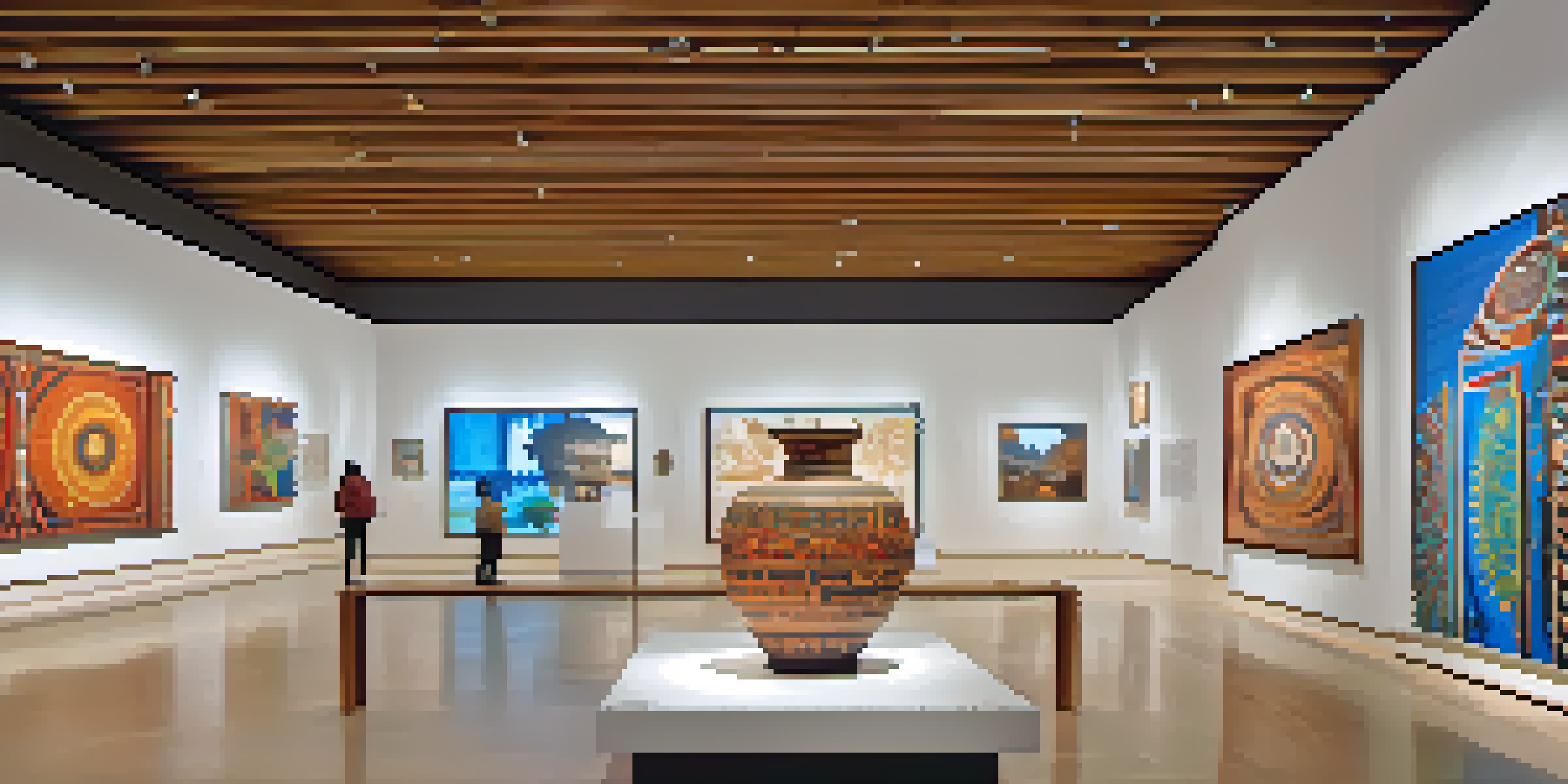Role of Museums in Preserving Cultural Heritage Through Art

Understanding Cultural Heritage and Its Importance
Cultural heritage encompasses the traditions, artifacts, and values that define a community. It includes everything from ancient artifacts to local folklore, shaping our identity and understanding of the past. Preserving this heritage is vital, as it connects generations and fosters a sense of belonging.
Cultural heritage is the legacy of physical artifacts and intangible attributes of a group or society that are inherited from past generations, maintained in the present and bestowed for the benefit of future generations.
Through cultural heritage, we learn about the diverse experiences that have shaped societies over time. This understanding can inspire empathy and appreciation for different cultures and histories. When we recognize the value of our shared heritage, we create a foundation for unity and respect among communities.
Museums serve as custodians of this vital cultural heritage, providing a space for reflection and learning. By conserving and displaying these artifacts, museums help ensure that future generations can access and appreciate the richness of their cultural history.
The Role of Museums in Art Preservation
Museums are often seen as treasure troves of art, housing invaluable works that span centuries and cultures. They play a crucial role in preserving these artworks, employing experts who understand the delicate balance of conservation and display. This process not only protects the art but also ensures its accessibility to the public.

Art preservation involves techniques such as climate control, restoration, and careful handling. For example, a fading painting may undergo restoration to enhance its colors while preserving its original essence. This meticulous attention to detail allows visitors to experience art in its intended form, connecting them to the artist's vision.
Cultural Heritage Builds Community
Preserving cultural heritage fosters a sense of belonging and connects generations through shared traditions and values.
Moreover, museums often collaborate with artists and scholars to develop new conservation methods. By staying at the forefront of technology and research, they can better safeguard artworks from environmental damage and degradation, ensuring that they remain vibrant for future generations.
Educational Programs: Engaging the Community
Museums do more than just display art; they also serve as educational hubs for the community. Through workshops, lectures, and guided tours, museums engage visitors in meaningful conversations about cultural heritage and the stories behind the art. This hands-on approach fosters a deeper understanding and appreciation of diverse cultures.
Museums are not just places to store artifacts; they are living institutions that engage and inspire communities to connect with their cultural heritage.
For instance, a museum might host a workshop where participants learn traditional art techniques from local artisans. Such experiences not only empower the community but also keep these artistic traditions alive. By actively involving visitors, museums create a dynamic environment that encourages cultural exchange.
Furthermore, educational programs often cater to various audiences, including school groups, families, and seniors. Tailoring these programs to different age groups ensures that everyone has the opportunity to explore and connect with their cultural heritage in a way that resonates with them.
Exhibitions: Showcasing Global Cultures
Exhibitions are a vital way for museums to showcase global cultures and highlight their unique contributions to the world. Through carefully curated displays, museums can tell stories that span continents and centuries, inviting visitors on a journey through time. This not only educates but also inspires curiosity and respect for diverse cultural expressions.
For example, an exhibition featuring indigenous art can illuminate the rich traditions and narratives of a particular community. By presenting these works alongside contextual information, museums help visitors grasp the significance of the art within its cultural framework. This approach fosters a deeper appreciation for the artistry and meaning behind each piece.
Museums as Educational Hubs
Museums engage communities by offering educational programs that deepen understanding and appreciation of diverse cultures.
Additionally, traveling exhibitions allow museums to share their collections beyond their local communities. This outreach expands the audience for cultural heritage and creates opportunities for dialogue and learning across borders, reinforcing the idea that art and culture are universal languages.
Digital Preservation: Connecting with the Modern World
In today’s digital age, museums are embracing technology to enhance the preservation of cultural heritage. Digital preservation involves creating virtual records of artworks and artifacts, making them accessible to a broader audience. This approach not only safeguards against physical deterioration but also allows individuals worldwide to engage with cultural treasures.
For instance, many museums now offer virtual tours and online databases where users can explore collections from the comfort of their homes. These digital resources can be particularly beneficial for students, researchers, and art enthusiasts who may not have the opportunity to visit in person. By leveraging technology, museums break down barriers and expand their reach.
Moreover, digital preservation can foster collaborative projects with other institutions, creating a global network of shared cultural knowledge. By working together, museums can pool resources and expertise, ensuring that cultural heritage remains vibrant and accessible in the digital age.
Cultural Sensitivity: Respecting Indigenous Narratives
As museums strive to preserve cultural heritage, they must also be mindful of the narratives they present, especially regarding indigenous cultures. It’s essential to approach these stories with respect and sensitivity, ensuring that the voices of the communities are heard and honored. This collaborative approach fosters trust and allows for a more authentic representation of cultural heritage.
For example, many museums are now working closely with indigenous communities to co-curate exhibitions, allowing these groups to share their stories in their own words. This perspective not only enriches the exhibition experience but also empowers communities to take ownership of their narratives. Respecting these voices creates a more inclusive and representative cultural landscape.
Embracing Digital Preservation
Digital preservation enhances access to cultural heritage, allowing wider audiences to explore and engage with art and artifacts online.
Ultimately, cultural sensitivity in museums is about recognizing the impact of representation. By valuing and prioritizing the perspectives of the communities whose heritage is being showcased, museums can contribute to healing and reconciliation, fostering a deeper understanding of our shared humanity.
The Future of Museums in Cultural Heritage Preservation
As we look to the future, the role of museums in preserving cultural heritage will continue to evolve. With advancements in technology and changing societal values, museums must adapt to meet the needs of diverse audiences. This means embracing innovative approaches to curation, education, and community engagement.
For instance, the integration of augmented reality (AR) and virtual reality (VR) can transform how visitors experience art and culture. These technologies can create immersive environments that bring history to life, allowing individuals to engage with cultural heritage in exciting and meaningful ways. By embracing these innovations, museums can attract a wider audience and create lasting connections.

Moreover, as global challenges such as climate change and social inequality arise, museums will play a crucial role in advocating for cultural preservation. By raising awareness and inspiring action, museums can become champions for cultural heritage, ensuring that it remains a vital part of our shared future.